Please Take Note: This is a review of the game’s final prototype. The art, game bits, and the rules discussed are all subject to change. The game is being reviewed on the components and the rules provided with the understanding that “what you see is not what you might get” when the game is published. If you like what you read and want to learn more, we encourage you to visit the Kickstarter project page to back it and get yourself a copy! Now that we have all that disclaimer junk out of the way, on with the review!
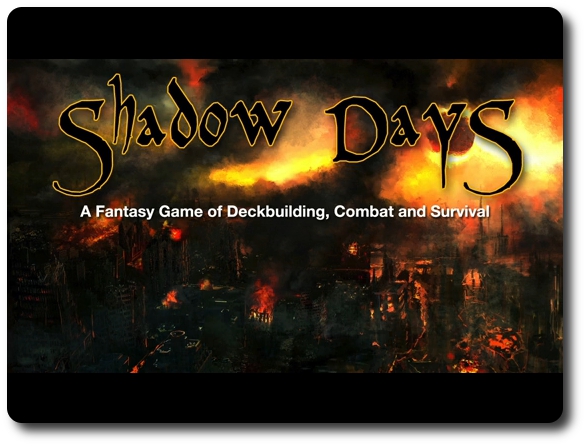
The Basics:
- For ages 7 and up (designer suggests 13+)
- For 2 to 4 players
- About 30 minutes to complete
Geek Skills:
- Active Listening & Communication
- Counting & Math
- Logical & Critical Decision Making
- Reading
- Strategy & Tactics
- Risk vs. Reward
- Hand/Resource Management
Learning Curve:
- Child – Easy
- Adult – Easy
Theme & Narrative:
- The land is plagued with darkness and all is strife and chaos – but some find the strength to rise and conquer all
Endorsements:
- Gamer Geek approved!
- Parent Geek approved!
- Child Geek approved!
Overview
It is unclear when the dark days first began but none now remember how the world used to be. Green and ancient forests are now twisted and dangerous places full of creatures too horrible to describe. Rivers and lakes have dried up or have been replaced with fetid swamps. Nature has become twisted and a mockery of what it once was. And while danger exists in every corner of the world, there are still those who find the strength to carry on and lead. You are one of those few who have found a way to turn misfortune into profit and power. But you are not alone.
Shadow Days is a card and dice game that will reportedly have 78 Creature cards, 12 Object cards, 15 Event cards, 5 Hero/Villain cards, 6 Stronghold cards, 8 Score cards, 8 glass markers, and 1 20-sided die. The artwork on the cards, for being a prepublished game, is simply outstanding and incredibly high quality. The art direction is moody without being terribly dark, full of interesting looking places and creatures. A special note here to inform Parent Geeks with little geeks who are still highly impressionable, that some of the artwork on the cards boarders on the downright creepy. All the text on the cards, including the rules and flavor text, are easy to read and to understand. To be perfectly honest, Shadow Days looks complete and like a professionally published game. An excellent feat considering it isn’t.
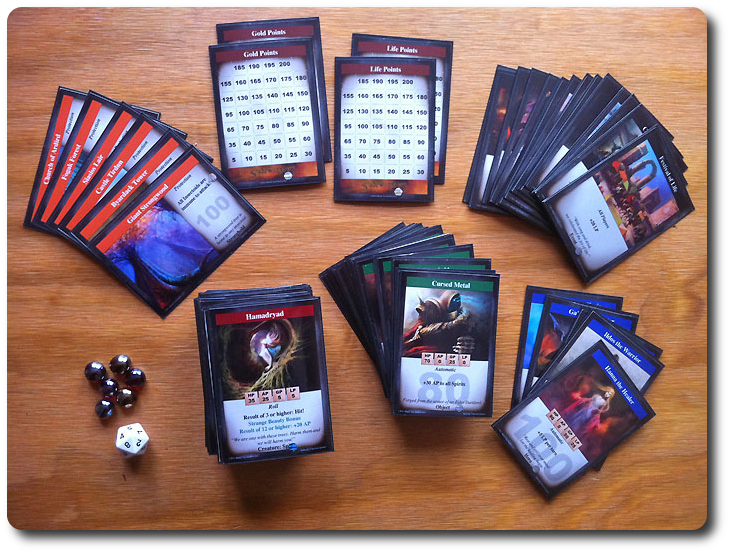
For technically still being an unpublished game, it looks outstanding!
Shadowy Cards
The cards in the game do everything, but the dice determines the outcome. Even the most powerful creatures still have a chance of failing and the most fool-proof of strategies might falter. The key to playing the game well is understanding what the card strengths and weaknesses are and their roles.
Creatures Cards
These represent the diverse and numerous humanoids, beasts, reptilians, insectoids, spirits, constructs, and creatures that are so bizarre that their origin is unknown. These are the most abundant resource a player can tap and use to further their goals.
Hero and Villain Cards
There are a few who walk the lands who are stronger than most, making a name for themselves, creating legends. Some are heroes who fight for the people and for a better way of life. Others have become as twisted as the world around them and seek only power. Regardless of their motive, they can be recruited and become your champions on the battlefield.
Object Cards
These represent equipable tools and objects of power found across the land that can be gathered and then given to Creatures, Heroes, and Villains to make them stronger and improve their odds of survival and victory. Object cards are placed on a player’s front line and are active. As a result, they can be targeted by other players and destroyed.
Stronghold Cards
These represent secure areas that have been conquered by the player and now defend the lands and places of power to house their army until needed. Creatures, Heroes, and Villain cards placed in the Stronghold are immune to all events and attacks, but cannot be used until they are moved to the front line. Strongholds only hold a specific type of card and can be considered something of a sidebar.
Event Cards
No matter how powerful a ruler might become, they cannot escape the fate of the land on which they live. Events are naturally occurring and impact all. Sometimes events are beneficial, but almost always, harmful to all.
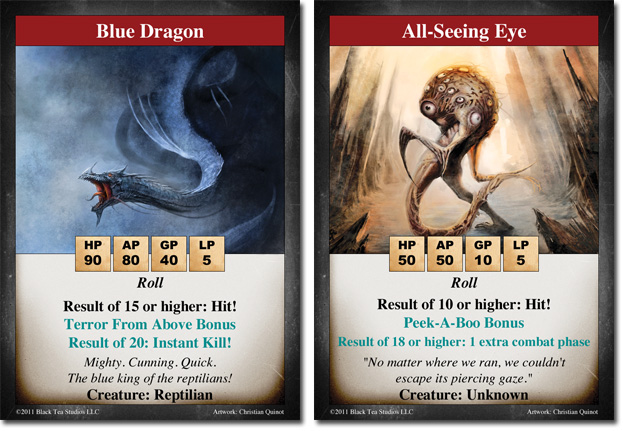
Example of just two of the MANY cards in the game
Actions, Bonuses, and Penalties
Depending on the card, it might list the type of action it can take, as well as any bonuses or penalties. Knowing these and understanding how they are used in the game will greatly benefit the player and help them make wise choices.
- Roll: the card requires the player to roll the 20-sided die. Depending on the roll, the outcome of the card’s effectiveness is determined.
- Automatic: the card is always “on” and does not need to be attached to a Creature, Hero, or Villain to be used.
- Modifier: the card modifies a card effect in some way – the modifier is based on the condition at the time the card is used and against what.
- Bonus: the card can add Actin Points (AP), Life Points (LP), and Gold Points (GP) and other things that are beneficial to the card’s owner, but seldom beneficial to the other players.
- Penalty: the opposite of a bonus, in every way.
Game Set Up
To set up the game, take and separate the cards into the following decks:
- Creature/Event cards
- Object cards
- Villain/Hero cards
- Stronghold cards
Shuffle each deck thoroughly. Once completed, place the Creature and Event deck face-down on the table in the middle of the playing area. This deck is now referred to as the “Pool deck”. Next to the Pool deck, place the Object, Hero/Villain, and Stronghold decks, face-up. The space directly after the Stronghold deck is reserved for discarded cards.
Next, give each player a Score card set. This includes one card that records Gold Point (GP) and one card that records Life Points (LP). Each player also gets 2 glass beads. To start with, each player places 1 glass bead on the 200 position on the LP card and on the zero position on the GP card.
When completed, each player, will draw five cards from the Pool deck, places the cards drawn face-up in a row of five cards in front of them. This is the player’s starting lineup of their front line. If an Event card is drawn, leave it in the line, but it does not trigger until the player’s turn.
Finally, every player rolls the 20-sided die. The player who rolls the highest wins the honor of going first.
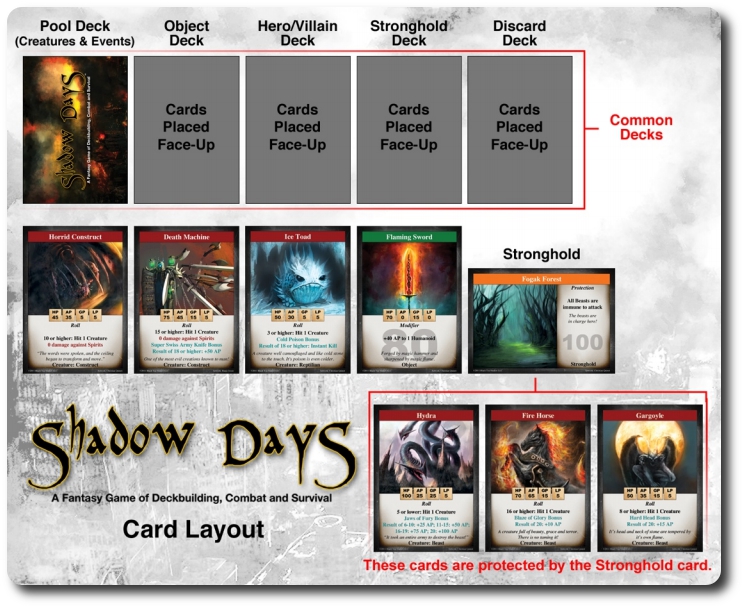
Example of game set up and in-play layout
Of Shadows and Dark Deed
Note: The rules of the game are summarized here but will be changing. As a result, we are not going to go into great detail about the specifics. We’ll summarize the rules as they were written at the time of this review. What this means to you is simple – don’t read what we are writing as the final rule set, but do read them because it’s the polite thing to do. Go to the Shadow Days Kickstarter project page to read the most up-to-date rules.Players take turns in the game completing actions. The actions they are allowed to complete are determined by the game’s turn order phase. In total, there are two phases which repeat continually until the game is completed. These phases are the combat phase and the regroup phase. After all the players complete one phase, the next phase starts, and so on.
Combat Phase
- If there are any Event cards on the front line, they are immediately resolved.
- The player selects one Creature, Hero, or Villain card to use this turn who will attempt to attack another player’s Creature, Hero, Villain, or Object card. Note that any card located in the Stronghold cannot be used or targeted.
- Object cards can be “equipped” by placing it under the Creature, Hero, or Villain card that is attacking. Note that multiple Object cards can be equipped.
- The Attacker declares their target and rolls the 20-sided die.
- If the roll result qualifies as a successful result (according to the card used), an Attack is initiated.
- Combat is quick and simple. All a player needs to do is compare their Creature, Hero, or Villain’s Attack Points (AP), adding any Object bonuses. If the AP is higher or equal to the target’s Hit Points (HP), the targeted card is removed from the game and sent to the discard pile.
- To the victor go the spoils and their GP value is increased in accordance to the card’s GP value that was just sent to the discard pile The player who just lost the card reduces their LP value in accordance to the card’s LP value. After these values have been updated, it is now the turn of the player to the left.
- If the roll result qualifies as a failed result (according to the card used), nothing happens (unless otherwise specified), and it is now the turn of the player to the left.
- Any Object card that has an automatic ability is triggered regardless of the outcome of the roll.
Regroup Phase
- The player draws one card from the Pool deck for every card lost during the Combat Phase and places them, face-up, on their front line or the player may now spend their GP to buy Object, Villains, Heroes, or Stronghold cards. The cost of each card is listed in their GP field. Player’s reduce their GP values according to the cost of the card.
- Already owned, newly purchased, and drawn cards are now placed on the player’s front line. If one of the cards purchased was a Stronghold, it is placed on the front line and up to three cards (that meet the requirements of the Stronghold card) can be placed under it. A player should never have more than 5 cards on their front line. If they have a Stronghold card, the player can have a total of 8 cards with 3 cards attached to the Stronghold card.
- Players may discard any of their cards (allowing them to draw or purchase another card) but this will cost them 10 LP per card discarded. If the Stronghold card is discarded, the player reduces their LP by 10, plus another 10 for every card in the Stronghold that are also discarded by default.
- If an Event card is drawn, the player cannot redraw or replace that card and it must remain on their player’s front line. However, it does not take effect until the player’s turn during the combat phase.
Play continues, alternating between the combat and regroup phase until the game ends.
Victory and Defeat
The last player to have LP wins the game. If an Event card triggers a reduction in LP that would cause all the remaining players to have their LP reduced to zero, the player with the most LP prior to the Event’s action is declared the winner.
To learn more about the game, read the full rules, and contribute to the Kickstarter campaign (if you should so choose), visit the Shadow Days official Kickstarter project page. I should note, that as of the release of this review, Shadow Days has been successfully funded, making it a “sure thing”.
Prediction
I’m going to make this short. Based on the easy game play, the outstanding art, the fantasy theme, and the unlimited replay, this game is going to be a hit, not only with my little geeks but also with my Gamer Geek crowd. Parent Geeks are a little harder to pin down. As previously mentioned, some of the artwork is creepy. Perhaps, depending on the age of the individual looking at the cards, a bit too creepy. There’s a fine line between “neat to look at” and “GADS! I SHALL NEVER SLEEP AGAIN!” for some of our littlest of little geeks who have a hard time processing some of the images they see. As always, parents are encouraged to take an interest in what their kids are doing and learn as much as possible. Not only to get involved in their lives but also determine if what they are doing is appropriate.
For my 4-year-old and 7-year-old, the card art is comparable to what is available in my D&D Monster Manual. Some of the art is creepy, but most of it is simply fascinating and exciting to look at. The casual observer will immediately recognize that a great deal of time and attention, as well as talent, went into the visual presentation of the game. This extra effort gives the game a very clean and professional feeling.
In fact, the cards were such a hit, my little geeks just wanted to look at them. After a 1/2 hour of doing so, they started separating them into stacks and then “trading” them. Once the trading was over, they battled them using a system that was never fully explained to me. I told them there was actually a game to be played with these cards, but for the first couple of days, they didn’t care to listen to me.
When I finally did get them to the table, they were eager to learn how to play. I explained the rules and gave them a brief demo. After I did so, my 7-year-old told me the game he and his brother made up was more complicated. I have no doubt that it was, but I bet the rules of Shadow Days make a lot more sense.
After going through the game a few times, explaining how the cards interacted, and the game’s goal, I dealt the cards to get our first game ready. I started to deal my 4-year-old in and he told me not to bother. He is not yet a strong reader, but is more than confident enough to always try. He took one look at the text on the cards and knew he was going to need a partner. I was more than happy to team up with him.
While I finished dealing out the cards, I asked my little geeks their thoughts.
“Wow! Really neat looking game! I like all the different monsters. That’s a lot of cards!” ~ Liam (age 7)
“Dad, can I be all the dragons?” ~ Nyhus (age 4)
Such excitement! They are ready to play and are annoyed I took the time to write down what they said for this review. Let’s see if their impatience with me is justified and this game is a blast.
Final Word
It has been said, but actually a number of people, that Shadow Days is a little like Magic: The Gathering and Ascension. I’ve never played Ascension, so I cannot speak intelligently to it. I have, however, played way too many hours and spent way too much money on Magic: The Gathering. Doesn’t make me an expert, mind you, but I would venture to say I can spot the similarities fairly easily. And, yes, Shadow Days is similar to Magic: The Gathering, but not terribly so. The strongest similarity is the combat. Simply compare two numbers and the higher number wins. The next similarity is the combat line and how damage is done to the player, but from that point on, the games are very different.
Shadow Days is positioning itself as a fantasy deckbuilding game of survival and strategy. After many plays of Shadow Days, I’d say it is very much a fantasy game of survival and strategy, but has little to do with deckbuilding. Where Magic: The Gathering encouraged players to buy many cards and build their own decks, Shadow Days only has one set of cards that all the player pull from, like Dominion. This is actually outstanding because it means only one player needs to have the game to play it with their friends. At most, the “deckbuilding” mechanism is how the player chooses to build their front line and what cards, if any, they want to put in their Stronghold. There is never any “deck” to build, only a battle line to manage. While some might see this as a detractor, I see it as one of Shadow Days great strengths. It makes the game easier to play without dumbing it down.
My little geeks loved the game. According to them, it felt “epic”. I wouldn’t go so far as to call it “epic”, but it was fun. Lots of fun, in fact. The game play is simple but there is a lot of variety in the cards which makes each game different and fresh. I found that my strategy all depended on what cards I had in my first draw. If I was heavy with beasts, I would keep focusing on beasts and attempt to chain objects. Most games that require this level of thinking and switching around would be too much for little geeks to manage; however, since you are only dealing with 5 cards at a time, your choices are always in front of you. All you ever need to do is attempt to make the best choice based on what has come before you and what will come after.
The results of the adults I played with were a mixed bag. The Parent Geeks liked how much their little geeks liked it, but if they had no experience with fantasy card games, they were pretty much lost. For a game that is light and easy to play, as well as teach, you need to be a Gamer to really appreciate it. Non-gamers pretty much took one look at it and walked away. Parent Geeks who were also gamers were ready to push the kids out of the way to have a chance to play at the table.
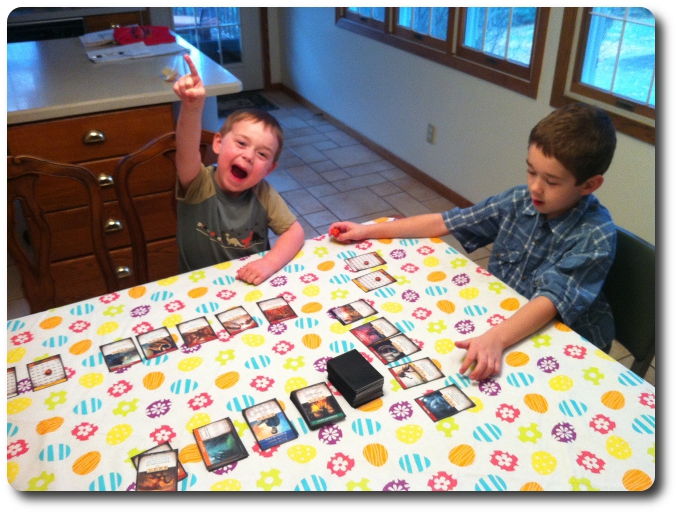
My 4-year-old shouts for joy as his brother looks on in disbelief at the horribly painful Event card he just drew
Gamer Geeks, this game is light, strategic, fast, and fun. The only reason I cannot see a Gamer Geek not enjoying Shadow Days is that they are not big on fantasy or light weight combat card games. The game is 100% perfect for quick play as a filler, opener, or a closer. It is not a deckbuilding game, in my opinion, but you do “build” your army as you play the game. An individual who is familiar with the cards will have a real advantage over another player, but the dice act as a soft equalizer, introducing a mild element of luck. But even that can be altered by focusing on getting the right objects.
Parent Geeks, again, take a moment to review the artwork before you put it in front of your little geeks. Nothing terribly risky here, but there are some creepy illustrations. There is a zombie creature, for example, that my 4-year-old just doesn’t want to look at. Game-wise, this is a great one but I think it will only appeal to those families who are already Gamer Geeks or working towards that most worthy goal. If your family already plays games a lot, you shouldn’t have any issue introducing Shadow Days at the table with great success.
Child Geeks, you are going to enjoy this game a great deal. Lots of monsters to play with and the game is easy to play. You might feel overwhelmed at first, but the game won’t feel unfair if you don’t know everything that is going on. Shadow Days will challenge you, but in a very fun way. When you are not playing the game, you’ll enjoy looking at all the cards!
I applaud the game designer’s choice to make this a non-collectible game and to move away from the deckbuilding mechanism used often in today’s card games. Instead of coming across as “just another card game”, it reuses tried and true elements of other games, focuses on speed and fun, and delivers at your gaming table. My biggest complaint is the lack of cards, honestly. I want there to be more of everything so there is even more opportunity for me to build a stronger 5-card army to crush my enemies! Hopefully, with a successful Kickstarter campaign, this will come to pass. There is a great opportunity here for the game to grow and to expand which has me very excited. If you are looking for a light and engaging fantasy based card game, you really need to go take a look at Shadow Days as soon as possible.
This game was given to Father Geek as a review copy. Father Geek was not paid, bribed, wined, dined, or threatened in vain hopes of influencing this review. Such is the statuesque and legendary integrity of Father Geek.




Pingback: Shadow Days Review by Father Geek | Black Tea Studios
Pingback: » Eminent Domain Game Review